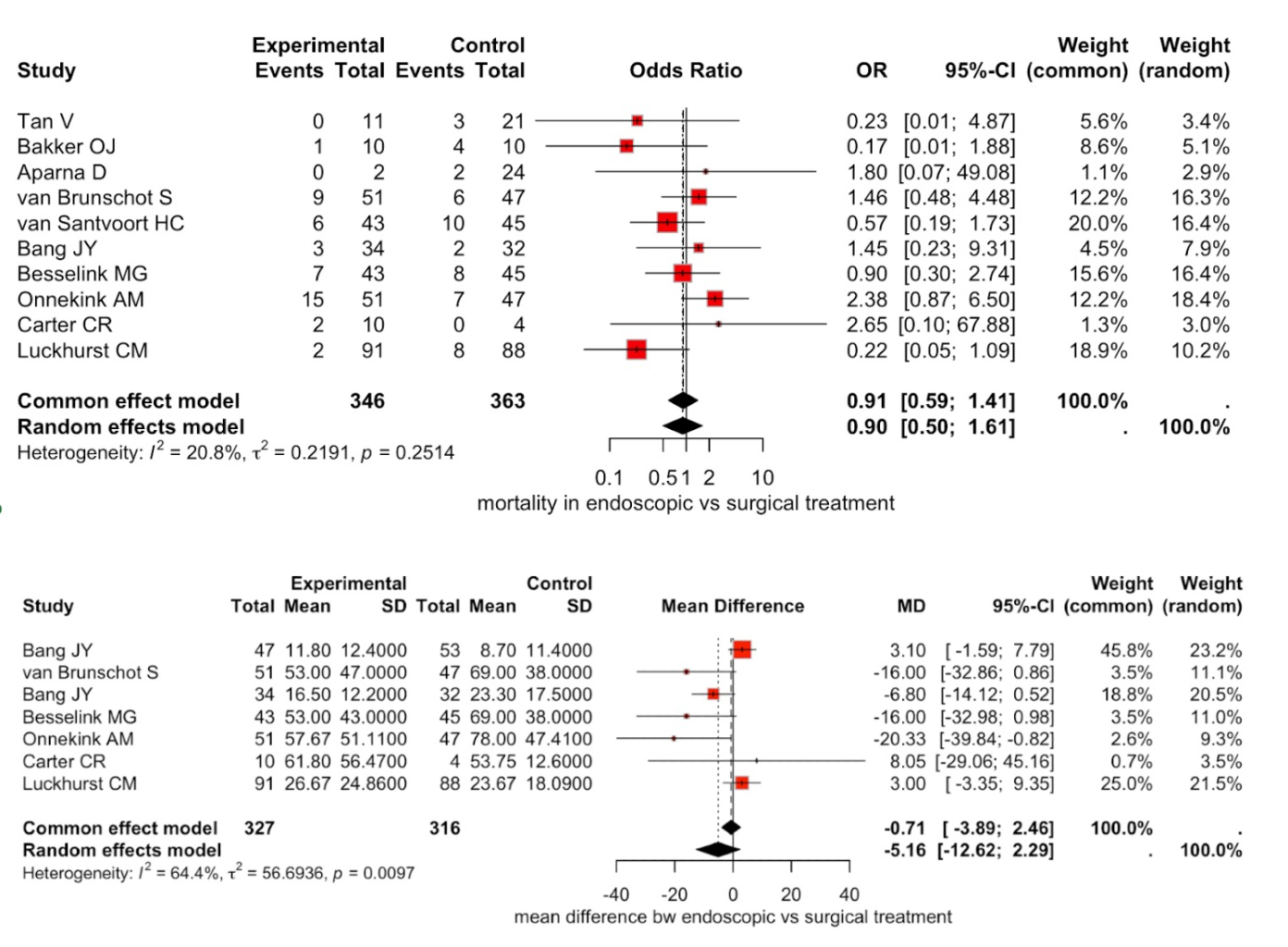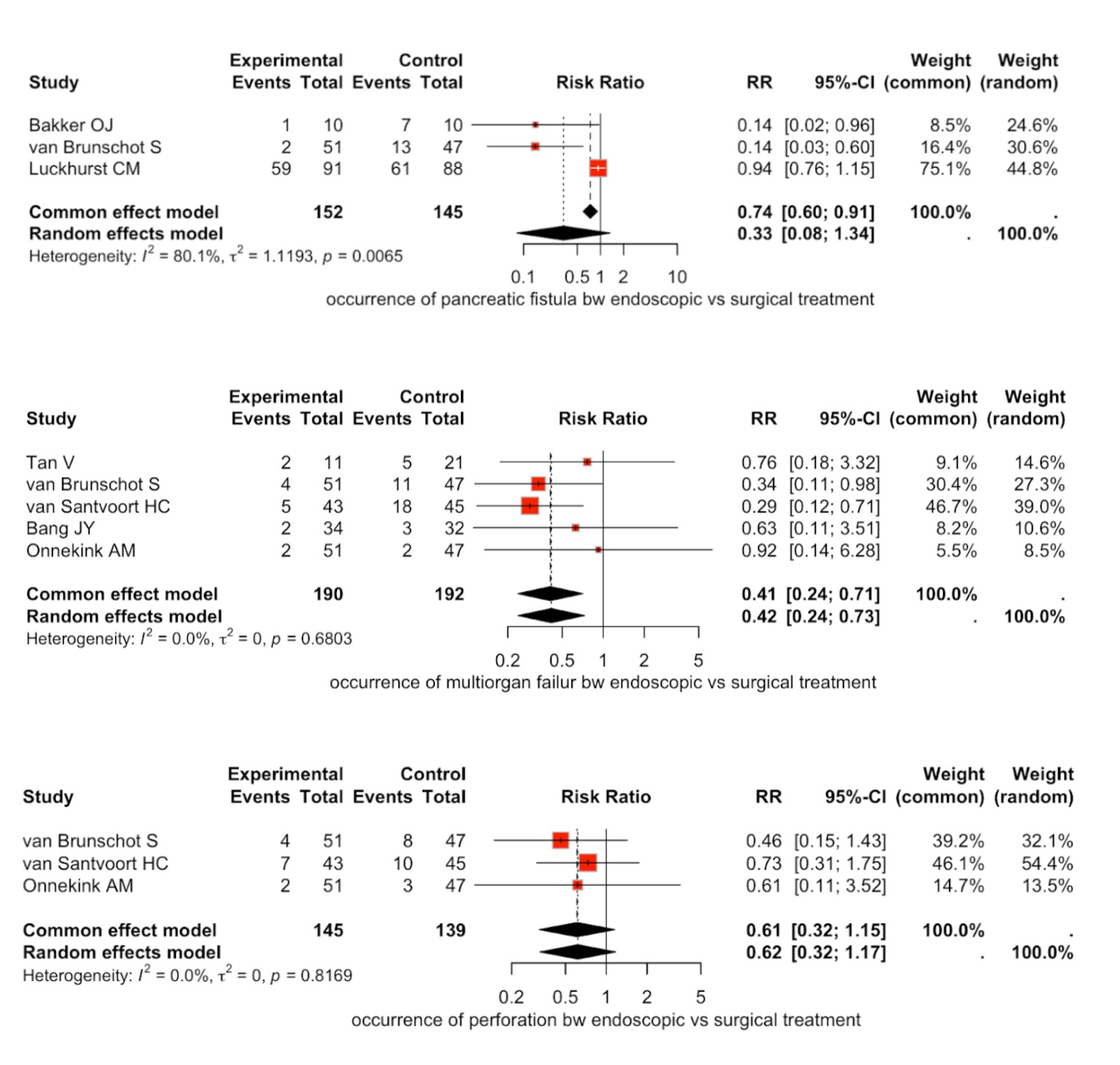Tuesday Poster Session
Category: Biliary/Pancreas
P4306 - Comparison of Outcomes in Open Surgical Necrostomy and Endoscopic Necrostomy for Infected Necrotizing Pancreatitis: A Systematic Review and Meta-Analysis
Tuesday, October 28, 2025
10:30 AM - 4:00 PM PDT
Location: Exhibit Hall
- VB
Vinay Bellur
Ramaiah medical college
Bangalore, Karnataka, India
Presenting Author(s)
Trisha Chandra Mohan, 1, Rishikesh R. Magaji, 1, Allama Prabhu N S, 2, Omar Oudit, DO3, Vinay Chandramouli Bellur, 4, Ananya Prasad, 5, Keerthi Balaji Babu Naidu, 4, Shradha Chervittara Karaveetil, 5, Pavan Kumara Kasam Shiva, 6, Druvadeep Srinivas, 7, Vibhav MS, 6, Anusha Giri, 5, Vardhini Ganesh Iyer, 1, Sravani Bhavanam, 8, Prakriti Ramamurthy, MBBS, MD9, Adithya Sathya narayana, MBBS10, Drumadala I. Gajbhiye, MBBS11
1BGS Global Institute of Medical Sciences, Bangalore, Karnataka, India; 2Bangalore Medical College and Research Institute, Bangalore, Karnataka, India; 3Brookdale University Hospital Medical Center, Brooklyn, NY; 4Ramaiah medical college, Bangalore, Karnataka, India; 5ramaiah medical college, Bangalore, Karnataka, India; 6bangalore medical college and research institute, Bangalore, Karnataka, India; 7rajarajeshwari medical college & hospital, Bangalore, Karnataka, India; 8Brookdale University Hospital Medical Center, Bangalore, Karnataka, India; 9University of Massachusetts Chan Medical School - Baystate Health, Springfield, MA; 10M S Ramaiah Medical College, Bangalore, Karnataka, India; 11Government Medical College and Hospital, Philadelphia, PA
Introduction: While open surgical necrosectomy was once the standard for Infected Necrotizing Pancreatitis (INP) it carries high morbidity and prolonged recovery. In recent years, minimally invasive endoscopic approaches have gained traction as safer alternatives, offering targeted drainage and debridement with reduced physiological stress. Emerging evidence suggests endoscopic treatment may lead to better clinical outcomes, including fewer complications and shorter hospital stays. This meta-analysis compares the efficacy and safety of endoscopic versus surgical interventions for managing INP.
Methods:
The review conducted follows the PRISMA guidelines. PUBMED, Google Scholar and Science-Direct, were searched using a comprehensive search term to identify and retrieve available articles. The articles included the assessment of outcomes following endoscopic and surgical management of INP.
The data was analysed using the Meta, Metadata and the Metafor packages of R Studio. The Odds Ratio (OR) of mortality between the two groups following endoscopy and surgical management for INP was considered the primary outcome. Mean difference in hospital stay, risk of multiple adverse events including the occurrence of pancreatic fistula, perforation, multiorgan failure and odds ratio of treatment success were considered as secondary outcomes. The Mantel-Haenszel method and the Inverse variance method were utilised to analyse the odds ratio and risk ratio.
Results: The study includes a total of 10 papers, which include a total of 346 subjects undergoing Endoscopic treatment and 363 subjects undergoing surgical treatment. The risk of mortality was statistically insignificant in both groups, indicating similar therapeutic efficacy.(OR = 0.91(0.59;1.41), p = 0.28) . The risk of developing pancreatic fistula(0.74), and perforation(0.62) was similar in both groups. The mean difference of hospital stay following the endoscopic procedure was significantly lower than the surgery procedure, indicating a quicker recovery (MDS = - 5,16(-12.62; 2.29),p = 0.0097). The risk of multiple organ failure was significantly lower in the endoscopic group (0.41(0.24; 0.72)).
Discussion: The study indicates similar clinical outcomes following endoscopic pancreatic necrostomy and surgical necrostomy for the management of Infected necrotising pancreatitis. Endoscopic therapies perform better in terms of adverse events and recovery time in comparison to surgical therapies.

Figure: mortality in endoscopic vs surgical treatment
AND
mean difference bw endoscopic vs surgical treatment

Figure: occurrence of pancreatic fistula bw endoscopic vs surgical treatment; occurrence of multiorgan failur bw endoscopic vs surgical treatment; occurrence of perforation bw endoscopic vs surgical treatment
Disclosures:
Trisha Chandra Mohan indicated no relevant financial relationships.
Rishikesh R. Magaji indicated no relevant financial relationships.
Allama Prabhu N S indicated no relevant financial relationships.
Omar Oudit indicated no relevant financial relationships.
Vinay Chandramouli Bellur indicated no relevant financial relationships.
Ananya Prasad indicated no relevant financial relationships.
Keerthi Balaji Babu Naidu indicated no relevant financial relationships.
Shradha Chervittara Karaveetil indicated no relevant financial relationships.
Pavan Kumara Kasam Shiva indicated no relevant financial relationships.
Druvadeep Srinivas indicated no relevant financial relationships.
Vibhav MS indicated no relevant financial relationships.
Anusha Giri indicated no relevant financial relationships.
Vardhini Ganesh Iyer indicated no relevant financial relationships.
Sravani Bhavanam indicated no relevant financial relationships.
Prakriti Ramamurthy indicated no relevant financial relationships.
Adithya Sathya narayana indicated no relevant financial relationships.
Drumadala Gajbhiye indicated no relevant financial relationships.
Trisha Chandra Mohan, 1, Rishikesh R. Magaji, 1, Allama Prabhu N S, 2, Omar Oudit, DO3, Vinay Chandramouli Bellur, 4, Ananya Prasad, 5, Keerthi Balaji Babu Naidu, 4, Shradha Chervittara Karaveetil, 5, Pavan Kumara Kasam Shiva, 6, Druvadeep Srinivas, 7, Vibhav MS, 6, Anusha Giri, 5, Vardhini Ganesh Iyer, 1, Sravani Bhavanam, 8, Prakriti Ramamurthy, MBBS, MD9, Adithya Sathya narayana, MBBS10, Drumadala I. Gajbhiye, MBBS11. P4306 - Comparison of Outcomes in Open Surgical Necrostomy and Endoscopic Necrostomy for Infected Necrotizing Pancreatitis: A Systematic Review and Meta-Analysis, ACG 2025 Annual Scientific Meeting Abstracts. Phoenix, AZ: American College of Gastroenterology.
1BGS Global Institute of Medical Sciences, Bangalore, Karnataka, India; 2Bangalore Medical College and Research Institute, Bangalore, Karnataka, India; 3Brookdale University Hospital Medical Center, Brooklyn, NY; 4Ramaiah medical college, Bangalore, Karnataka, India; 5ramaiah medical college, Bangalore, Karnataka, India; 6bangalore medical college and research institute, Bangalore, Karnataka, India; 7rajarajeshwari medical college & hospital, Bangalore, Karnataka, India; 8Brookdale University Hospital Medical Center, Bangalore, Karnataka, India; 9University of Massachusetts Chan Medical School - Baystate Health, Springfield, MA; 10M S Ramaiah Medical College, Bangalore, Karnataka, India; 11Government Medical College and Hospital, Philadelphia, PA
Introduction: While open surgical necrosectomy was once the standard for Infected Necrotizing Pancreatitis (INP) it carries high morbidity and prolonged recovery. In recent years, minimally invasive endoscopic approaches have gained traction as safer alternatives, offering targeted drainage and debridement with reduced physiological stress. Emerging evidence suggests endoscopic treatment may lead to better clinical outcomes, including fewer complications and shorter hospital stays. This meta-analysis compares the efficacy and safety of endoscopic versus surgical interventions for managing INP.
Methods:
The review conducted follows the PRISMA guidelines. PUBMED, Google Scholar and Science-Direct, were searched using a comprehensive search term to identify and retrieve available articles. The articles included the assessment of outcomes following endoscopic and surgical management of INP.
The data was analysed using the Meta, Metadata and the Metafor packages of R Studio. The Odds Ratio (OR) of mortality between the two groups following endoscopy and surgical management for INP was considered the primary outcome. Mean difference in hospital stay, risk of multiple adverse events including the occurrence of pancreatic fistula, perforation, multiorgan failure and odds ratio of treatment success were considered as secondary outcomes. The Mantel-Haenszel method and the Inverse variance method were utilised to analyse the odds ratio and risk ratio.
Results: The study includes a total of 10 papers, which include a total of 346 subjects undergoing Endoscopic treatment and 363 subjects undergoing surgical treatment. The risk of mortality was statistically insignificant in both groups, indicating similar therapeutic efficacy.(OR = 0.91(0.59;1.41), p = 0.28) . The risk of developing pancreatic fistula(0.74), and perforation(0.62) was similar in both groups. The mean difference of hospital stay following the endoscopic procedure was significantly lower than the surgery procedure, indicating a quicker recovery (MDS = - 5,16(-12.62; 2.29),p = 0.0097). The risk of multiple organ failure was significantly lower in the endoscopic group (0.41(0.24; 0.72)).
Discussion: The study indicates similar clinical outcomes following endoscopic pancreatic necrostomy and surgical necrostomy for the management of Infected necrotising pancreatitis. Endoscopic therapies perform better in terms of adverse events and recovery time in comparison to surgical therapies.

Figure: mortality in endoscopic vs surgical treatment
AND
mean difference bw endoscopic vs surgical treatment

Figure: occurrence of pancreatic fistula bw endoscopic vs surgical treatment; occurrence of multiorgan failur bw endoscopic vs surgical treatment; occurrence of perforation bw endoscopic vs surgical treatment
Disclosures:
Trisha Chandra Mohan indicated no relevant financial relationships.
Rishikesh R. Magaji indicated no relevant financial relationships.
Allama Prabhu N S indicated no relevant financial relationships.
Omar Oudit indicated no relevant financial relationships.
Vinay Chandramouli Bellur indicated no relevant financial relationships.
Ananya Prasad indicated no relevant financial relationships.
Keerthi Balaji Babu Naidu indicated no relevant financial relationships.
Shradha Chervittara Karaveetil indicated no relevant financial relationships.
Pavan Kumara Kasam Shiva indicated no relevant financial relationships.
Druvadeep Srinivas indicated no relevant financial relationships.
Vibhav MS indicated no relevant financial relationships.
Anusha Giri indicated no relevant financial relationships.
Vardhini Ganesh Iyer indicated no relevant financial relationships.
Sravani Bhavanam indicated no relevant financial relationships.
Prakriti Ramamurthy indicated no relevant financial relationships.
Adithya Sathya narayana indicated no relevant financial relationships.
Drumadala Gajbhiye indicated no relevant financial relationships.
Trisha Chandra Mohan, 1, Rishikesh R. Magaji, 1, Allama Prabhu N S, 2, Omar Oudit, DO3, Vinay Chandramouli Bellur, 4, Ananya Prasad, 5, Keerthi Balaji Babu Naidu, 4, Shradha Chervittara Karaveetil, 5, Pavan Kumara Kasam Shiva, 6, Druvadeep Srinivas, 7, Vibhav MS, 6, Anusha Giri, 5, Vardhini Ganesh Iyer, 1, Sravani Bhavanam, 8, Prakriti Ramamurthy, MBBS, MD9, Adithya Sathya narayana, MBBS10, Drumadala I. Gajbhiye, MBBS11. P4306 - Comparison of Outcomes in Open Surgical Necrostomy and Endoscopic Necrostomy for Infected Necrotizing Pancreatitis: A Systematic Review and Meta-Analysis, ACG 2025 Annual Scientific Meeting Abstracts. Phoenix, AZ: American College of Gastroenterology.
